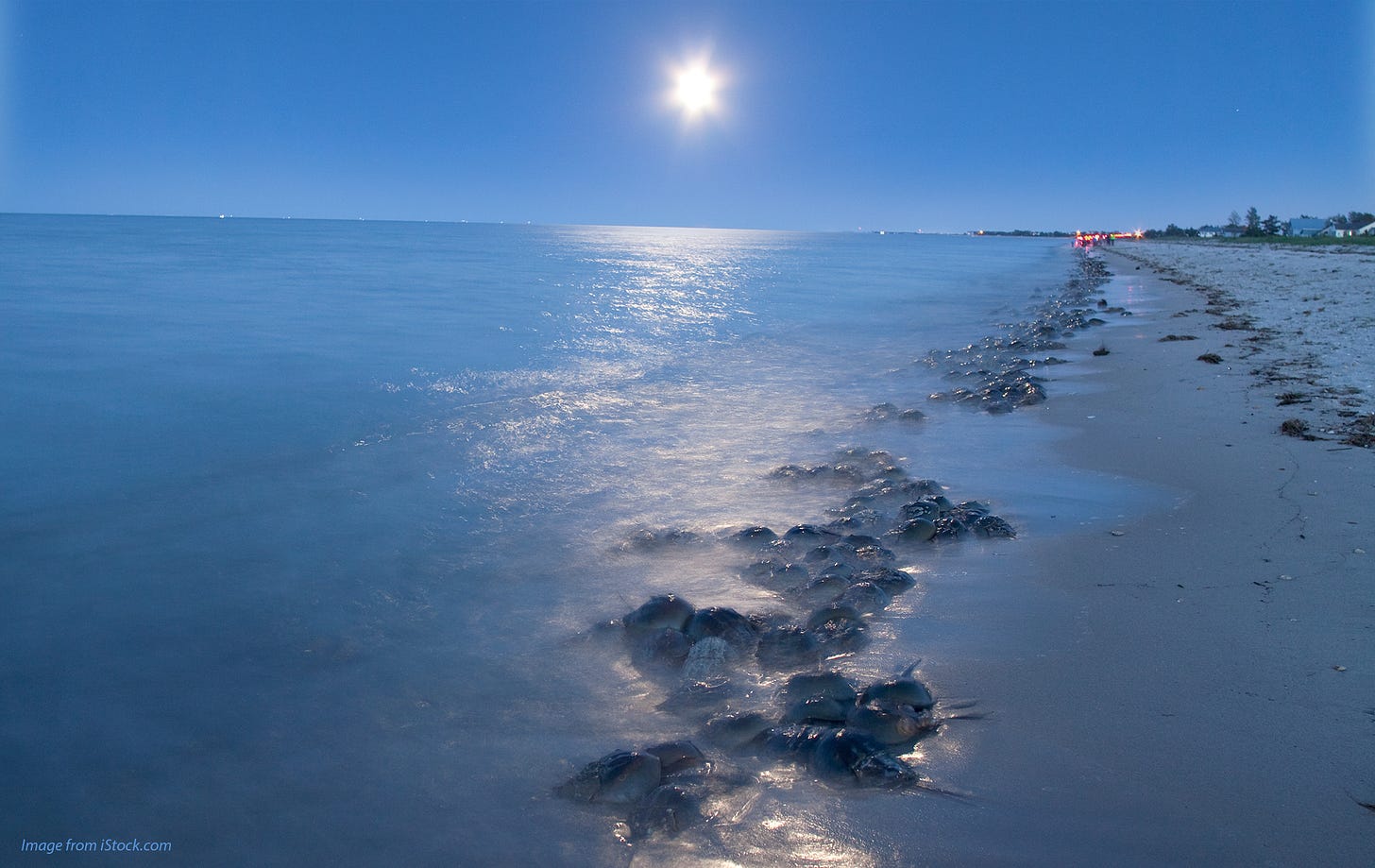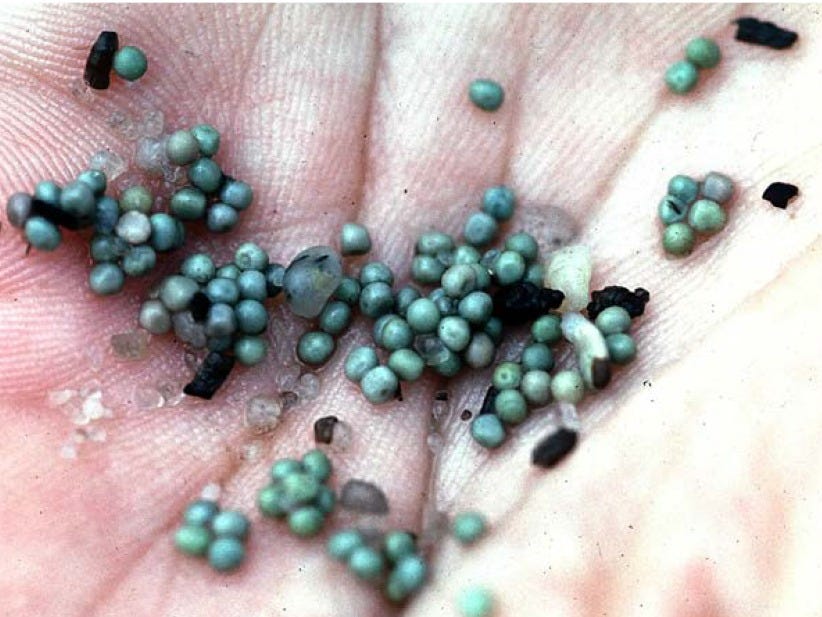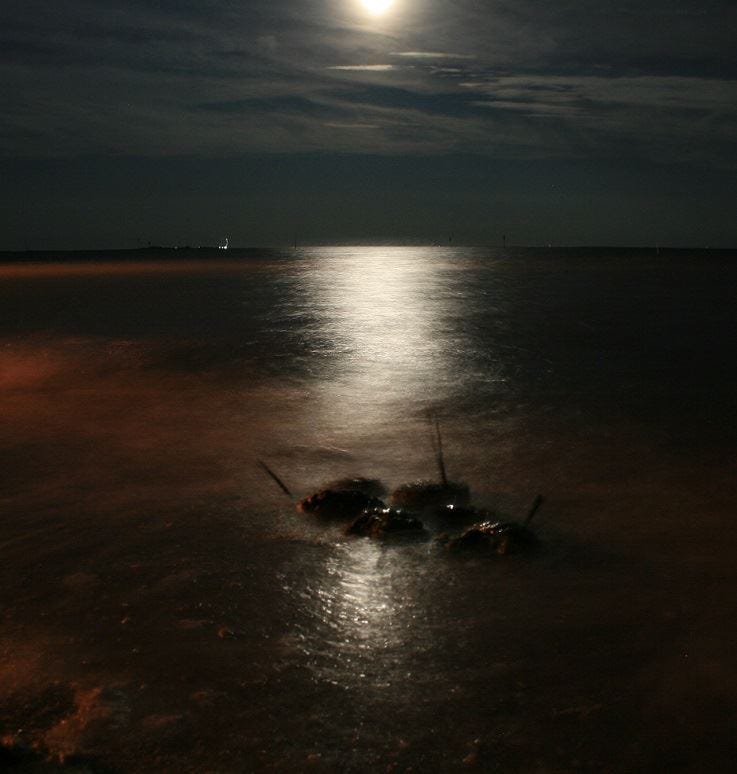Horseshoe Crabs Lived Through Five Mass Extinction Events. But Will They Survive Offshore Wind?
Even a NJ Audubon official admits Mid-Atlantic offshore wind leases are not responsibly sited. But nothing has slowed the speed of their approval and development.

As they have for eons each spring during a full moon, prehistoric-looking creatures emerge from the surf in great numbers when the tide is high. The millions of eggs female American horseshoe crabs deposit in nests dug in the sand not only ensure the preservation of Limulus polyphemus, but of birds, fish, crabs, and turtles, including endangered loggerhead sea turtles and the threatened rufa red knot that depend on the eggs for survival.
But despite managing to survive on Earth for over 450 million years, including making it through planetary upheavals that erased the dinosaurs, these ancient mariners may finally be reaching the end of the line. Sacrificed for fertilizer and bait, and harvested secretly to be used by biomedical companies for its one-of-a-kind blood, this unique species is now on the verge of having its sole federally protected maritime habitat threatened by industrialization in the name of “going green.”
‘It’s just unknown’
Centered close to the mouth of Delaware Bay, just off the coastlines of both New Jersey and Delaware and extending out into mostly U.S. waters, sits the Carl N. Shuster Jr. Horseshoe Crab Sanctuary. This 1,500-square-mile reserve, named after the “founding father” of horseshoe crab science, was officially designated a “closed area” in 2001 by the National Oceanic and Atmospheric Administration (NOAA). Not only is the capture of horseshoe crabs prohibited there, but any caught incidentally in fishing are required to be “returned to the water.”
While the American horseshoe crab has a coastal range that extends from the Gulf of Maine to Florida and even down to the Yucatan peninsula, there is no disagreement among experts that the largest concentration of horseshoe crabs in the world resides in Delaware Bay. This makes the issuance of five large offshore wind leases encroaching on the Shuster reserve, two smack in the middle, by the federal Bureau of Ocean Energy Management even more bizarre.
When made aware of these offshore wind areas, Dr. John Tanacredi, professor of earth and environmental sciences at Molloy University in Long Island, New York, and director of the Center for Environmental Research & Coastal Oceans Monitoring, called it “outrageous.”
According to Tanacredi, who has been dubbed the “horseshoe crab whisperer” due to his decades of study on the arthropods, there is no existing research on the impacts that offshore wind may inflict on horseshoe crabs. “There isn’t any data, not even a single observation type of study or one simulated in a laboratory,” he maintains. “It just doesn’t exist.”
“There’s nothing about the EMF concerns, there’s nothing about the construction concerns. They’ve looked at other wind energy developments in Europe and elsewhere . . . but these are in our nearshore ocean, it’s just unknown,” Tanacredi added.
Other L. polyphemus experts confirm that nothing is known about the effects offshore wind facilities may have on the animals, either through construction, operation, or decommissioning.
Biology Professor H. Jane Brockmann, at the University of Florida (who was also unaware of the planned development in the reserve) found it “particularly worrying” when informed about it.
“The reserve has been important for maintaining healthy populations of horseshoe crabs in Delaware Bay,” where large juveniles develop before breeding, she said.
Environmental groups such as New Jersey Audubon are in the preposterous position of cheering on offshore wind projects, yet stating they must be “responsibly sited.”
Asking Dr. David Mizrahi, VP of research and monitoring at New Jersey Audubon, if turbines planned for the Shuster sanctuary are indeed responsibly sited, he said “No... we don’t support any encroachment on it. There’s no way of knowing if there will be an impact and what’s the point of designating a reserve if we allow development to take place?
“We’ve expressed our dismay over any development in the Shuster reserve or for that matter any development that would affect the movement of birds into and out of Delaware Bay.”

Delaware Bay area beaches are crucial for nesting and a major stopover point in the Atlantic flyway—an avian “superhighway” migratory birds use to traverse great distances to breeding and wintering areas. This is especially true for the rufa red knot, a small shorebird listed as “threatened” under the Endangered Species Act. This little bird travels an astounding 9,000 miles south to north every spring, only to do it again in reverse during the fall. But surviving the journey depends on an abundance of horseshoe crab eggs.
“We measure horseshoe crab population health as it relates to shorebirds,” said Mizahi. He added that red knot population levels are directly connected to the number of spawning horseshoe crabs.
But the uncertainties regarding 1,000-foot-tall turbines pounded into the seabed, hundreds upon hundreds of miles of submarine cables carrying power, and other disturbances to the benthic zone where horseshoe crabs and other seafloor animals live, feed, and develop haven’t stopped BOEM from forging ahead with what it calls the “government-sanctioned demands for offshore wind energy.”
Currently, just in the Mid-Atlantic region off Delaware Bay, Orsted, PSEG, and US Wind and Equinor are in various stages of leasing and permitting to populate the location with hundreds of offshore wind turbines. Two lease areas, comprising around 100,000 acres of seabed, sit directly within the boundaries of the Shuster Sanctuary.
But what does BOEM, the lead agency in all matters of offshore wind, have to say about this?
Consulting the final environmental impact statement for Maryland Offshore Wind, in which forty-two square miles of the wind project are slated to be within the reserve, one finds dozens of mentions of horseshoe crabs.
For example, it’s acknowledged that the lease area not only infringes on the sanctuary but that it will include around twenty-five miles of buried cable. “Horseshoe crabs likely use areas in the vicinity of the Offshore Export Cable Route for overwintering habitat and individuals may cross (it) . . . during annual migrations between breeding beaches and offshore areas,” the document states.
Sediment and seafloor disruption, mortality of “sensitive invertebrates like horseshoe crabs,” and even a map outlining the reserve were also covered in the 661-page, highly repetitive text. But BOEM’s conclusion, based on little to nothing, is that the “proposed action” would cause “minor, moderate, (even) beneficial” impacts to “benthic resources” and invertebrates.
Then there was mention of a “modeling study” on electromagnetic field (EMF) effects sponsored by US Wind and conducted “due to the importance of the horseshoe crabs and shellfish to the Mid-Atlantic.”
Despite the study being summarized by BOEM as determining that the “electric field produced” at the site would not affect horseshoe crabs, that wasn’t what it found. Nor was the US Wind-funded research even about horseshoe crabs (which are not true crabs or crustaceans, but more closely related to spiders and scorpions).
When it came to the sensitivity of “large invertebrates,” the study authors stated that previous research with “large crustaceans . . . cannot be relied upon to predict effects from the Project’s 60-Hz AC sources of EMF. Unfortunately, relatively little laboratory research has been conducted on the behaviors and physiological responses of marine invertebrates to AC magnetic fields,” it said.
“My frustration,” said Tanacredi, “has been that this is a significant organism. Its survivability alone should be reason to protect it, yet we know nothing about the impacts.”

Of bait and blood
Although seemingly large numbers of horseshoe crabs emerge to spawn on Delaware Bay area beaches during the spring and early summer, said by Delaware Fish & Wildlife to be in the hundreds of thousands, their population crashed during the 1990s due to “an explosion” in commercial bait harvesting.
According to the Center for Biological Diversity, numbers have “declined to historic lows,” with the Delaware Bay horseshoe crab population having fallen by two-thirds.
Filing a petition to list the American horseshoe crab under the U.S. Endangered Species Act in February 2024, the group—along with twenty-five organizations who co-signed (most all of which also strongly support offshore wind), including the Physicians Committee for Responsible Medicine, The Humane Society of the United States, and New Jersey Audubon—are still awaiting a response from NOAA.
Will Harlan, CBD senior scientist, said aside from bait takes for commercial whelk and eel fisheries, the biggest threat to the species is the secretive harvest by the biomedical industry for its literal blue blood. Known as limulus Amebocyte Lysate (LAL), this incredibly unique clotting agent found in the blood of horseshoe crabs, which goes for around $15,000 a quart, was until recently the only way drugs and IV devices were tested for bacterial endotoxin contamination. The height of covid vaccine manufacturing saw the “largest horseshoe crab blood harvest ever recorded,” of around one million animals, the CBD petition stated.
While approximate numbers are given out related to how many horseshoe crabs are taken to be bled, and how many survive and are released, the actual statistics are classified.
“A needle is punctured into their hearts and blood is drained out of their bodies,” said Harlan. “A lot is hidden behind closed doors, and most probably don’t survive. No studies have been done, all this is hidden in a shroud of secrecy. We can’t even find out how many are supposedly returned to the water,” Harlan added.
To that end, in May 2024 the group filed a lawsuit in the Maryland Circuit Court for the release of information into how many horseshoe crabs are “killed, bled or injured by pharmaceutical companies and fishermen annually.”
With a synthetic version of LAL recently being approved by US Pharmacopoeia, Harlan (who was also unaware of the proposed development in the Shuster reserve), believes that “we now have a solution,” despite pharma’s “resistance to change” from the blue blood original.

‘The last frontier on earth’
Not including an upcoming lease sale in the Gulf of Maine on October 29, at this point, BOEM has auctioned off thirty-one wind energy leases in the outer continental shelf from Massachusetts to North Carolina representing nearly three million acres of seabed. If developed, these projects will create a wall of enormous spinning structures, each as tall as the Eiffel Tower, and well within view of the shoreline. And there’s more to come.
As Dr. Tanacredi puts it, “It’s a very scary circumstance in the big picture of things. Once these get started and aren’t falling apart and providing some energy, this is going to be an endless addiction.”
Tanacredi worries that the impact of offshore wind “along with everything else,” particularly bait harvest and bycatch from fishing, presents “cumulative” damage to horseshoe crabs.
On September 5, US Wind’s Maryland project received yet another approval from the Department of Interior to move ahead with what will total 114 offshore turbines and four offshore substation platforms as close as 8.7 nautical miles from the coast of the northern Delmarva peninsula, with expanses infringing on the sanctuary that was created twenty-three years ago to protect the American horseshoe crab.
“Science is not done by consensus,” Tanacredi noted. “It’s done by scientific methodology, it’s done by being predictable and skeptical and questioning everything and making sure it supports the final conclusion and it’s repeatable.”
To Tanacredi, the horseshoe crab represents an intrinsic aspect of what he has come to regard as “the last frontier on earth” for science to understand. Yet there is virtually no study that has been done on how “green” offshore wind energy will impact the fate of this irreplaceable resource before the government, in collusion with private—and largely foreign-based—enterprises encourages it to proceed at full throttle, not unlike some sort of environmental Titanic.
The phenomenon is one to which Tanacredi himself can personally attest, having been unable to secure financial support for such research, even as a longtime professor.
“I can tell you there’s a bias, there’s no doubt about it,” he contends, “when the mantra says this is what’s happening, if you’re not going along with that, you’re not going to get funded for it.”




I happened to be sitting next to an engineer, who built the substations for Vineyard Wind, at dinner last night and he said the project was improperly cited. He also said there wasn't enough testing before hand and acknowledge the manufacturing problems with the VW turbines.
Thank you for such an incredible piece. A veritable treasure trove of fascinating and awe inspiring information. Senator John Warner of Virginia said it best when he introduced a bill that read simply:
“No government must ever be allowed to dispense in any way our public lands for private profit.”
This was attached to a defense bill which failed just before Cape Wind.